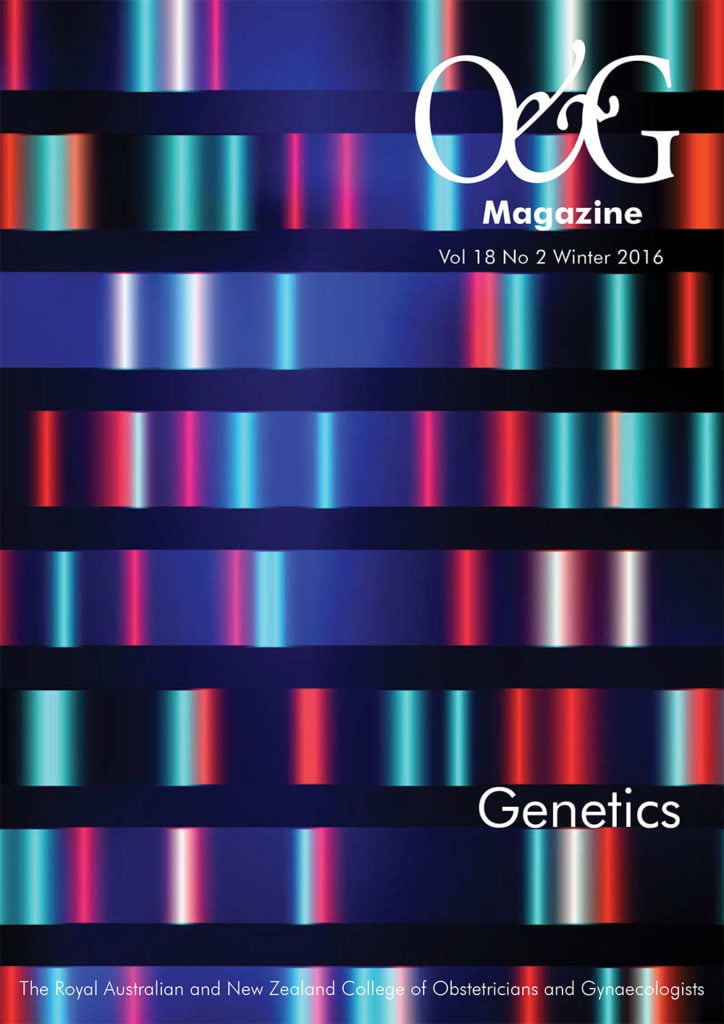This is the first of what will be a regular feature in O&G Magazine, written with the aim of linking the Australian and New Zealand Journal of Obstetrics and Gynaecology (ANZJOG), the College’s academic journal, with O&G Magazine which, while it also publishes clinical articles, aims to provide opinion, news and comment as well.
April issue – 56(2)
The April 2016 issue of ANZJOG (56:2) kicks off with a review from Kidson-Gerber and five other experts titled, ‘Caring for pregnant women for whom transfusion is not an option. A national review to assist in patient care’. Every practising obstetrician will have come across this challenge, which is associated with increased rates of maternal morbidity and mortality. While conceding that high-quality evidence is difficult to find, the authors manage as comprehensive a look as possible at what is available from cohort studies, case series and reports together with basic physiological principles, and have produced a pragmatic approach to the management of the problem. They strongly recommend a multidisciplinary ante- and perinatal plan, including attention to pre-delivery haemoglobin levels and iron stores, minimising blood loss, haemorrhage control and postnatal management. This is important reading for all obstetricians.
A second useful review, by Wong and Merkur, explores the anatomy of the inferior epigastric artery in relation to the surface anatomy, and will be of interest to everyone performing, or learning to perform, abdominal surgery.
New original research
Among the original articles in obstetrics are contributions from two very different places – the first from Monash, the second from Papua-New Guinea – on the assessment of pregnancy care. Sinni et al evaluate a clinical audit tool to measure the quality of antenatal and intrapartum care in their Melbourne hospital; Tanimia et al look at the value of WHO guidelines for ‘near-miss’ situations in obstetric practice in Port Moresby General Hospital. Dipping in further you will find an article by Kohlhoff et al that highlights the relative lack of screening for postnatal depression among women attending for private obstetric care in Australia; also articles investigating intravenous iron infusions, and the use of vitamin and herbal supplements in pregnancy.
Under original articles in gynaecology is a study by Brown and King of age-stratified changes over 20 years in surgical procedures for urinary stress incontinence. They identify the mid-urethral sling as now being the most commonly performed procedure. Blain et al look at the feasibility of ‘see-and-treat’ for high-grade Pap smears, and Sozen et al recommend combined adjuvant radiotherapy and chemotherapy in early uterine cancers.
June issue – 56(3)
In the upcoming June issue you will find four articles and an invited editorial dealing with the reproductive health of Aboriginal and Torres Strait Islander women. There are some positive findings among these, but also much evidence to show that we are far from Closing this Gap. There are also, among many other topics, an interesting look at gestational surrogacy in Australia; an article recommending more communication and consistency among those responsible for giving information to the parents of very preterm babies; and a paper detailing the prevalence of thyroid dysfunction among women attending a private obstetric practice.
Expert reviews
Wherever possible, each issue of ANZJOG will contain at least one, and sometimes more, expert reviews on topics relevant to current obstetric and gynaecological practice. In general, reviews are by editorial invitation only, but readers are invited to submit suggested topics for editorial consideration.
Opinion pieces
While many opinion pieces appear in O&G Magazine, there is also a place in ANZJOG for the reasoned debate of clinical controversies in our specialty. Such pieces may include both sides of an argument in the one article or there can be articles from two authors, each exposing a viewpoint. Opinion pieces submitted to ANZJOG are subject to the same intellectual rigour applied by the peer-review process as original research.
Letters to the Editor
These are always welcome. In general they will be responses to recent articles, and will add something more to the topic. When submitted in a timely manner, it is possible for letters to the editor to appear in the issue subsequent to the one in which the original article appears.
Peer reviewers
We are constantly seeking enthusiastic reviewers for submissions. More than 200 manuscripts are considered for publication annually, which means we need at least 400+ reviews. Almost all practising obstetricians and gynaecologists should be able to review from time to time. Without reviewers, ANZJOG would not exist. So if you are interested, contact Sarah Ortenzio via: [email protected].
Data repositories
A number of journals now require authors to submit all data sets related to their research for permanent storage and access. Other researchers then have free access in order to verify or attempt to duplicate research findings, and to extend further research based on these findings. Wiley, the publisher of ANZJOG, has embarked on a pilot data repository project with other journals, but not at present with ANZJOG. One of the concerns is who will pay for these repositories; overseas, applicants for research grants are now starting to require funds from major grant bodies to include a component for continued data storage. However, for the clinicians conducting smaller projects within their own institutions or practices that comprise a reasonable number of ANZJOG contributors, the way forward is not yet clear. Further news is awaited!






Leave a Reply